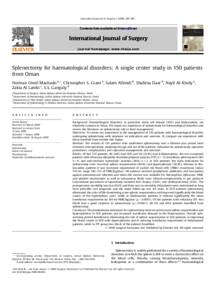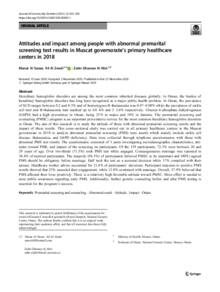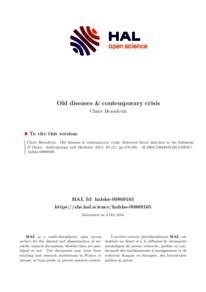Document
Splenectomy for haematological disorders : a single center study in 150 patients from Oman.
Identifier
DOI: 10.1016/j.ijsu.2009.08.004
Contributors
Grant, Christopher S., Author
Al-Kindi, Salam., Author
Daar, Shahina., Author
Al-Kindy, Nayil., Author
Al-Lamki, Zakia., Author
Ganguly, S. S., Author
Publisher
Elsevier Ltd.
Gregorian
2009-08
Language
English
Subject
English abstract
Background: Haematological disorders, in particular sickle cell disease (SCD) and thalassaemia, are relatively common in Oman. We report our experience of splenectomy for haematological disorders and review the literature on splenectomy role in their management. Objectives: To review our experience in the management of 150 patients with haematological disorders undergoing splenectomy with emphasis on indications and outcome. To compare our experience with those reported from outside this region. Methods: The records of 150 patients who underwent splenectomy over a thirteen year period were reviewed retrospectively, analyzing the age and sex of the patients, indication for splenectomy, operative procedures, complications, peri-operative management and outcome. Results: Of the 150 patients, 96 (64%) had SCD and 34 (22.6%) had β-thalassaemia; the rest comprised patients with refractory idiopathic thrombocytopenic purpura (ITP) n = 12, hereditary spherocytosis (HS) n = 6, and auto-immune haemolytic anaemia (AHA) n = 2. In SCD patients, the main indications for splenectomy were recurrent splenic sequestration (60.4%) and hypersplenism (36.4%), whereas in thalassaemic patients it was increased requirement of packed red blood cells (PRBC) transfusion (mean 310 ml, range 242-372 of PRBC/kg/year). All patients received prophylactic antibiotics and vaccination against pneumococcal infection and when the vaccine was available for Haemophilus influenzae. PRBC and platelet concentrates as well as intravenous fluids were infused preoperatively as per protocol. Concomitant procedures at laparotomy included liver biopsy (14.6%) and cholecystectomy (8.6%). The postoperative morbidity was low (8.6%) and there was no mortality. All patients were maintained on long term penicillin and proguanil, and the mean follow-up was 4.6 years. In SCD patients splenectomy eliminated the risks of life threatening acute splenic sequestration and improved significantly the blood counts of the hypersplenic cases, while in thalassaemic patients it reduced significantly the mean transfusion requirement by 100 ml PRBC/kg/year (p < 0.0001). Of the patients with refractory ITP, two thirds had a good response to splenectomy (p < 0.0001). All HS and AHA patients benefited from splenectomy. Conclusion: The predominant indications for splenectomy were recurrent acute splenic sequestration and hypersplenism in SCD patients, and increased transfusion demand in the thalassaemics. Overall, splenectomy proved beneficial in eliminating the risk of splenic sequestration in SCD patients, in improving the blood counts in SCD with hypersplenism and in reducing transfusion requirement in thalassaemic patients, while in ITP group two thirds of the patients benefited.
Member of
ISSN
1743-9191
Resource URL
Category
Journal articles



